Stillpoints Ultra 5, Ultra SS, Ultra Mini and Ultra Base
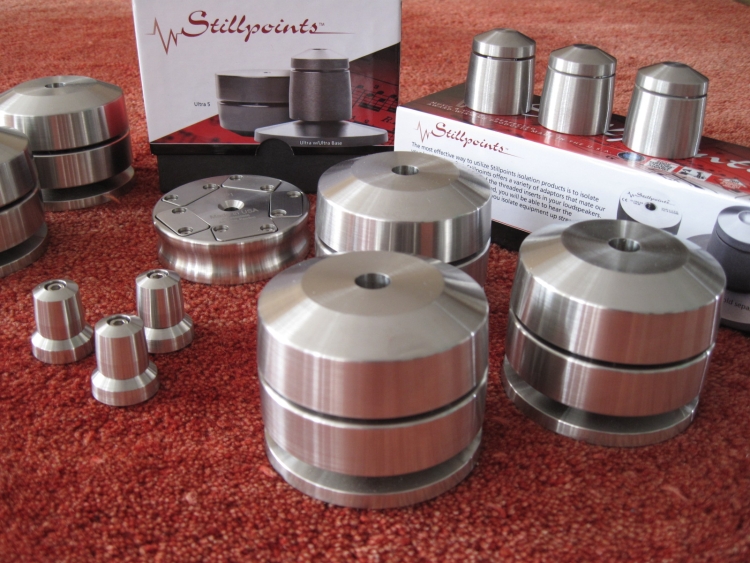
Stillpoints Ultra 5
These are big and heavy beats! Really, there’s no preparing you for this until you see them in person and hold them in your hand.
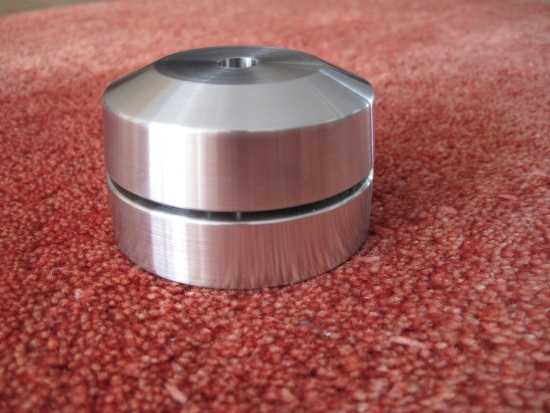
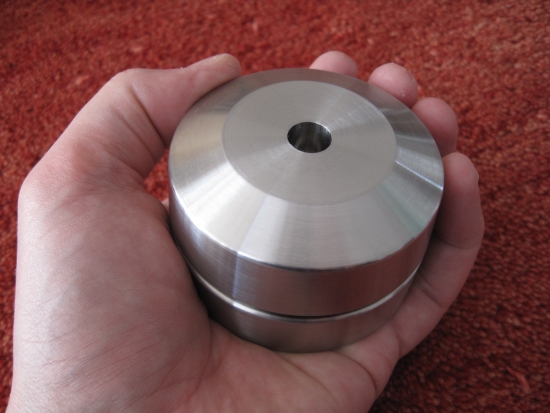
The Stillpoints Ultra 5 are heavy-duty footers. It is said that the supported weight is without limit and once you have held them in your hand, you will believe it! There’s no use in using these under source components, rather, they can be used under speakers and equipment racks, or as in my case, under the Jeff Rowland power amps.
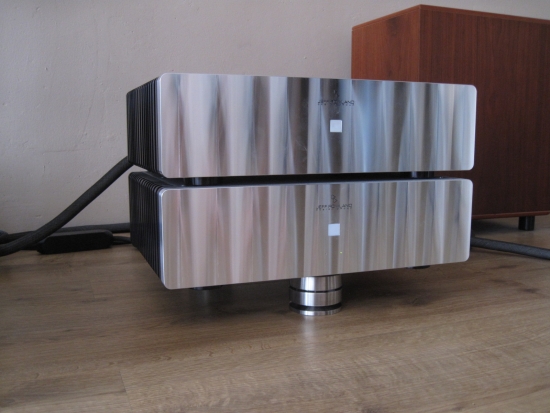
Stillpoints Ultra 5 with Ultra Base
First used in combination with the Ultra Base, 1 set of 3 Stillpoints 5 was installed under each Model 6/BPS6 where previously the amps were placed directly on the floor with their own solid aluminum feet. The Stillpoints 5 were the first items to be reviewed, before the Ultra SS and Ultra Mini on the previous page. So the following tests were done with the regular system which is the Levinson 390S as transport into the Rowland Aeris DAC. I didn’t use the 818 or the other Stillpoints elsewhere in the system.
Adding the Ultra 5’s did change the sound a lot. But was it all better? Initially, that seemed to be the case indeed. The bass performance of my system really stunned me now: it tightened up and became more rhythmic and propulsive. It was now much more articulate and exact but also gained more drive and solidity. In fact, this was the very best bass I have yet heard from my system. Or any other system I owned for that matter.
Moving up the frequency ladder, the midrange was clearer defined, with better articulation and precision, yet, without becoming forward or shouty. Moving further up the frequency range, I was expecting the treble to become dry, perhaps even dark. But even if it did become a little drier, this wasn’t detracting from an otherwise very well-balanced sound. So, on balance I only heard improvements.
Sure enough, technically speaking everything was better.
And indeed, some recordings became more lifelike and more convincing. But later that evening, and even more so the next day, after I had listened to more CD’s, there was something about the sound that didn’t quite agree with me.
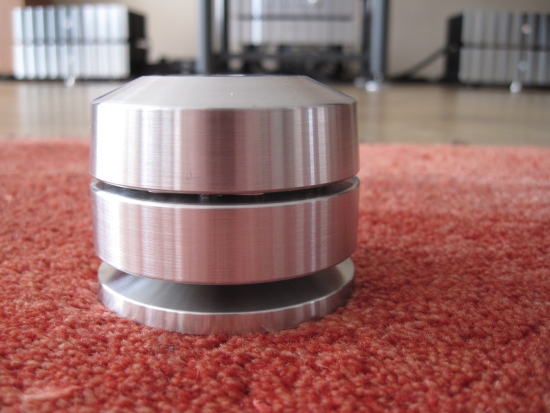
When a listening buddy came along a few days later and we listened for a while he agreed with me that my system sounded off-balance. In spite of the superb bass and excellent resolution, we both felt less involved with the music so I proposed we remove the Ultra 5’s with his help.
Back on their own feet, the Rowland sounded familiar again. The soundstage was a lot more laidback, but rather more generous and acoustically more convincing. Tonality was darker yet treble was airier and had longer decay. Imaging with the Stillpoints was rather different than without them: without Stillpoints the stage started behind the speakers and stretched towards the listener where needed. With Stillpoints it was always a little forward and seemed too controlled, it didn’t “breathe” as much. That’s a matter of taste of course. But as I grow older, I tend to prefer more relaxed staging. This sense of overt control may be the result of another aspect of the Stillpoints’ sound, which is authority. Their sound is one of super high res sound, presented in a very controlled manner, making for a very clean sound, which is very appealing in itself. But it seems to invoke a sense over overt control which my system couldn’t cope with well.
More striking however was the feeling that instruments lost a degree of tonality and fullness: piano sounded like keyboard. Contrabass sounded like a regular electrical bass. This is very much dependent on system synergy of course. I know that my Magnepan 3.6’s aren’t very full in the midbass and just maybe they need the extra bloom that is added when you set up your power amps directly on the floor.
Dynamically the Stillpoints are very good, adding to the tension and realism. Yet, for my speakers, it seems to be a little too much. This aspect of the presentation reminded me of how the bottom level of my Spider racks used to sound: overly controlled and too tight. Again: for someone with a fuller and darker sound, big B&W’s perhaps, the situation might well be reversed. But for me and my system the Stillpoints 5 were just a little bit too much. Without them I felt more connected to the music and was more emotionally moved. Even if the bass was now back to being merely allright, I still preferred the presentation without the Stillpoints 5. More on this further down below as the Ultra 5 test continues in a friend’s system.
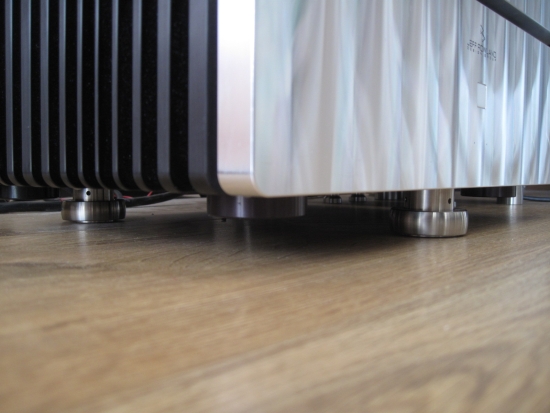
Cerapucs
Substituting the Ultra 5s with Cerapucs made for an unsuspected but welcome change in perspective. Although I was used to listening without them, the substitution of the Spider rack for the Artesania Exoteryc rebalanced the system and even if the Cerapucs previously never worked well, I felt that the Stillpoints did so much good for the bass, that I simply had to try the Cerapucs again. Sometimes things just fall into place and this was such an occasion: the Cerapucs brought back some bass timing and agility while maintaining the relaxed but living, breathing soundstage and full tonality. Although the Cerapucs couldn’t even come close to the Ultra 5’s bass performance, on balance it was good enough for me.
Because I would later learn that the Ultra Base would prove too much in my application when added to the smaller Ultra SSses, I also briefly listened to the Ultra 5s without the Bases afterward. But here I found their omission not to benefit the sound. Removing the Bases didn’t make for a fuller tonality or more emotion. Rather, it took away from the Ultra 5’s previously splendid bass performance and it lessened overall tonality and impact. So, if you’re going for the 5’s, I’d recommend using them with Ultra Bases.
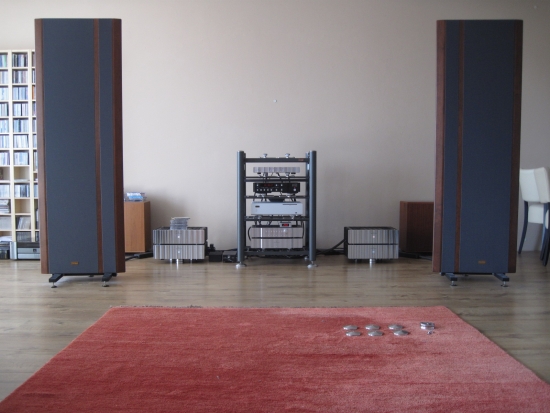
Setup 2
Being somewhat unsatisfied with the Ultra 5 results in my own setup, I took them to a friend’s setup to form a second opinion.
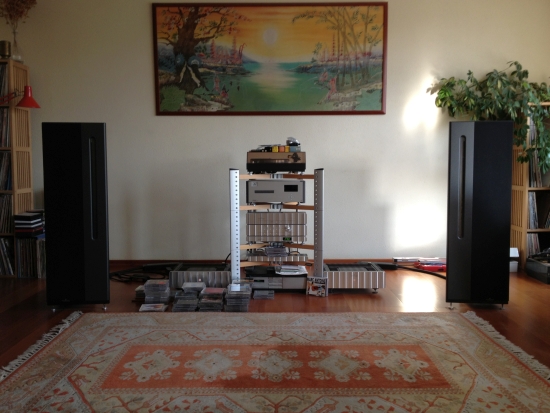
As can be seen in the photo above, this setup is very similar to my own. Room size and listening position/distance are roughly the same. The differences are:
- Spider rack instead of Artesania Exoteryc
- Also Rowland Model 6 but no BPS6
- Also Rowland preamp but Synergy IIi instead of Coherence II
- Apogee Centaur hybrid planar speakers instead of Magnepan MG3.6R
- Wadia 861B CD player instead of Levinson 390S + Rowland Aeris DAC
- No earthing instead of everything earthed
- Natural wood floor with dual damping (cork and felt) instead of Laminate
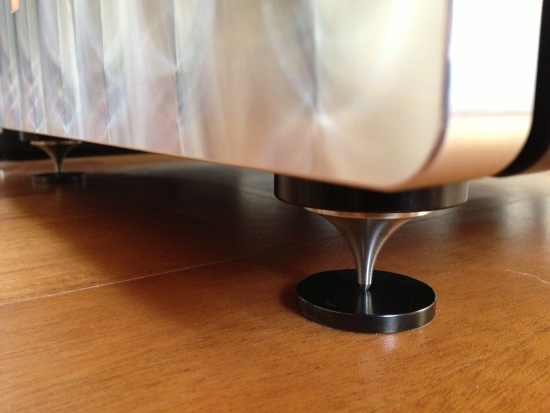
Normally the Model 6 amps rest on steel spikes that rest on Wadia platters. This is different from my own setup in which these spikes don’t work. This system however behaves a little differently in spite of the large similarity to my own system. This time I tried all possible positions in one session: sloped side up, sloped side down, with and without Ultra Base.
Sloped side up, without Ultra Bases
This was the position that I had also used during the earlier listening tests in my own system. The sound was familiar with all the improvements in the same areas: Deeper, more solid, yet more articulate bass -check. More pronounced midrange -check. Blacker background -check. But this time there were other positive aspects, too: Not only was the bass fuller, but tonality throughout the entire frequency range was also much better. Whereas big acoustical instruments like Piano and Contra Bass sounded smaller in my setup, in the friend’s setup they actually gained credibility and sounded if anything, more acoustical. Like in my setup, treble was just a hint drier, but still plenty fluid. On balance the sound was already much better than I had heard it in my setup – and we weren’t even using the Ultra Bases yet! We both sat there, amazed, at the differences in perspective between the otherwise so similar systems.
Sloped side down, without Ultra Bases
Perplexed. That’s how I felt the first minute after turning the Stillpoints upside down and listening to the same track. The sound was 100% the reverse of what we had just heard: the sound now was strangely colored, phasey, and lacking openness throughout. Bass lost its articulation, treble missed extension and overall the positive feel was just gone. I can’t explain it but after another track, we were convinced that this was not the way to go and reversed the Ultra 5’s again. Ah, bliss.
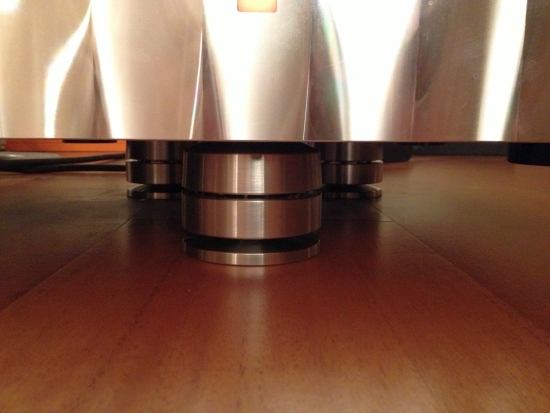
Sloped side up, with Ultra Bases
Now we added the Ultra Bases. I screwed them on only hand-tight, so not overly tight to the 5’s. Again I was perplexed, but this time in an entirely positive manner. Back was the full, positive, articulate, airy presentation but with added benefits: treble was even airier, bass was even fuller and the midrange was a little more relaxed, less forward and more colorful for it. This was a sound that we could both get used to. The friend was even counting his pennies as he searched for possibilities to acquire the Ultra 5’s. Ultimately though, the pricing was what held him back. We tried to tweak his sound using the means he has in-house afterward, but couldn’t get close. Sure, we could obtain airier treble and that nice rhythmic sound was also achievable, but the fulness of timbre let alone the bass performance was unattainable otherwise. The only thing that was better without the 5’s was the freedom in the soundstage. Like in my own setup, we sometimes experienced a feeling of too much control. But this was only evident with more upbeat music and to a far lesser extent than in my own system.
Why, now, would the Ultra 5’s perform so differently depending on setup? In a word: System Synergy. But there’s a catch. This time, we both concluded, it was probably not so much the system itself that was making the difference, but the floor. You see, my own floor is laminate. That’s HDF with a plastic layer of imitation wood. The friend’s floor is natural wood with dual damping: a thin cork layer over a thick layer of felt.
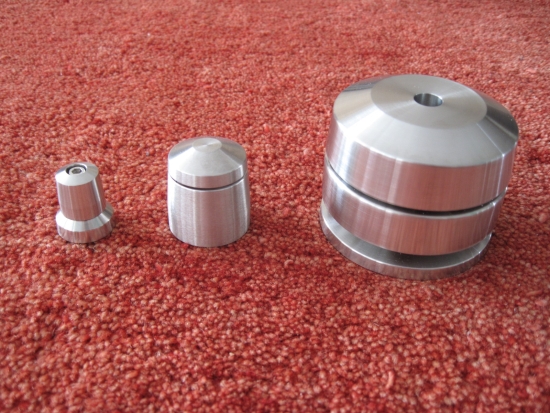
Conclusion
In my reviews, I keep repeating the mantra “Balance Is Everything” and once again there seems to be a lot of truth in it. Getting better accessories can sure lift the performance of your system. Big time. But it is no guarantee for better, or more involving sound. The Stillpoints, perhaps even more so than other couplers, are very system-dependent. While I really like the smaller Ultra Minis and Ultra SS, the Ultra 5s were ultimately not a good match in my own system, even if they provided the best bass I have yet heard my system produce. They might have made an excellent match however in the system based around B&W 802D’s, that I had a few years ago.
Listening to the Ultra 5’s in a friend’s system however was nothing short of a revelation: his sound improved so much that we were simply perplexed. More importantly, in this system, the 5’s portrayed only a hint of the overt control that I heard when using them in my own system. System Synergy is the magic word here.
The Ultras (both Minis and SS) are really dangerous: hear them once and you’ll be addicted. They are so effective that other such accessories, even products that are akin to the Stillpoints principle, such as Finite Elemente Ceraballs, pale by comparison. Such is the added agility, resolution, and subtlety, that Ceraballs sound comparatively dark and dull. Of these two versions, ultimately, the Ultra SS is my favorite, for its more complete, fuller, more visceral sound and wider soundstage but the Ultra Mini comes remarkably close, and given their relatively modest price it should definitely be on your shortlist.
External Links
Manufacturer: Stillpoints
Distributor for the BeNeLux: HVP Audio

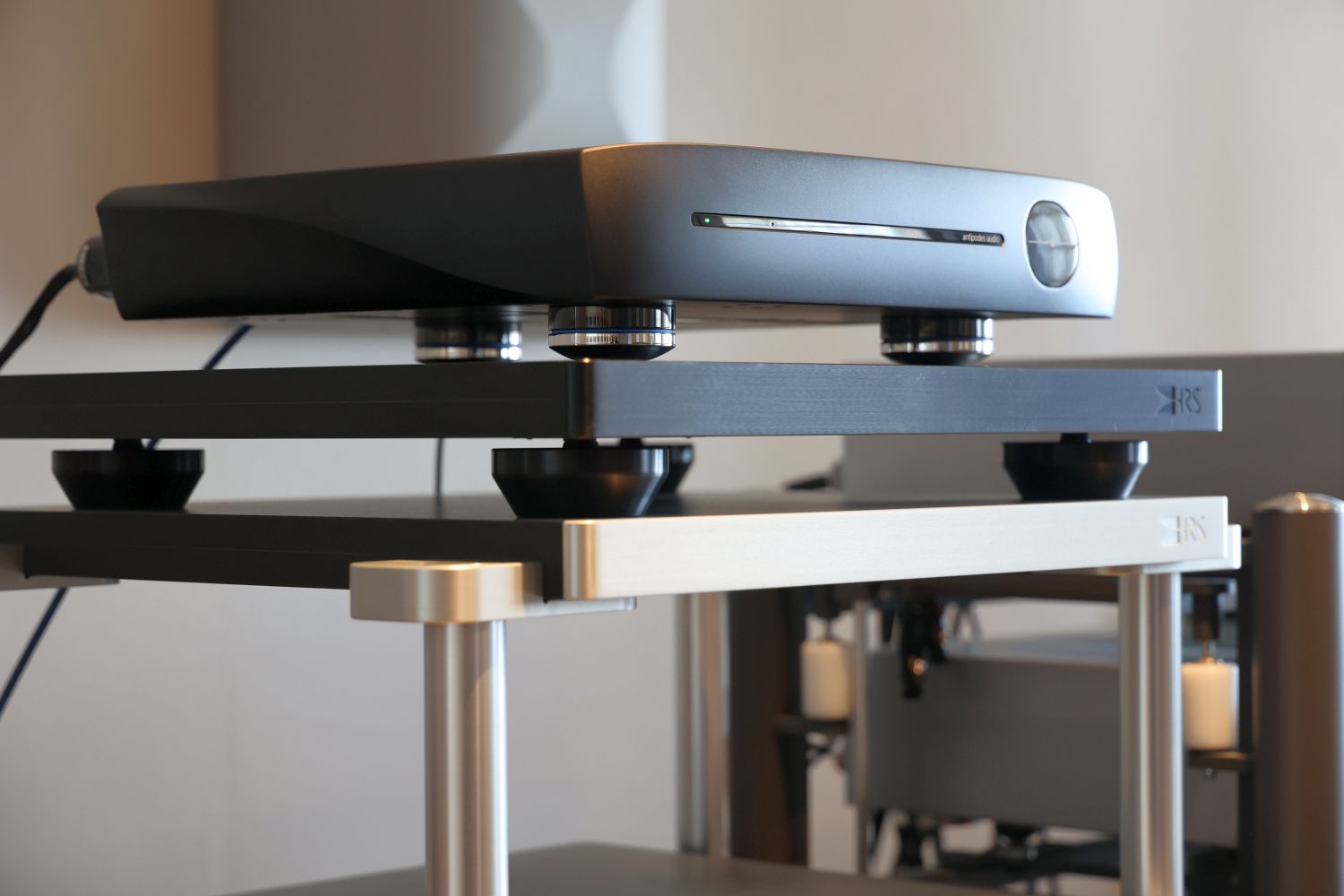


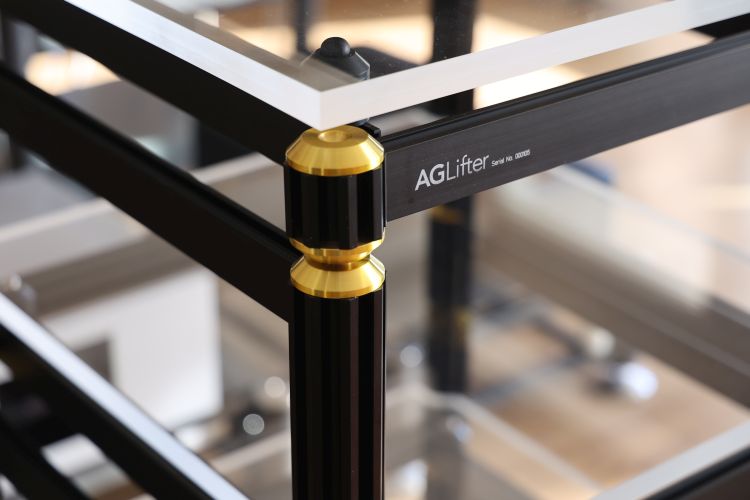
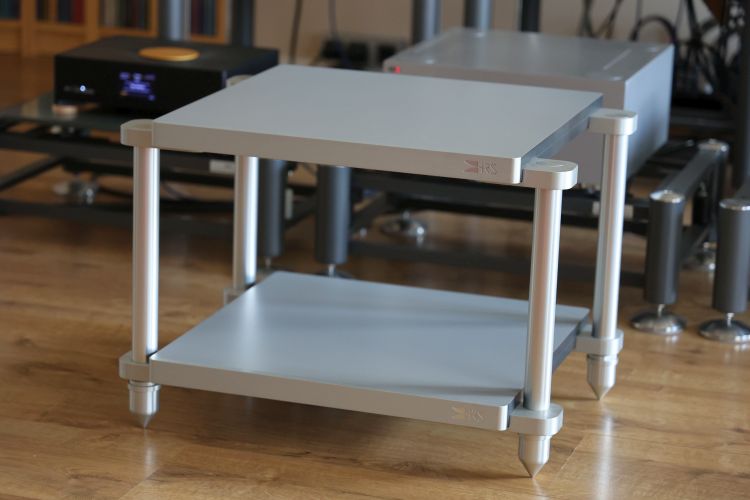
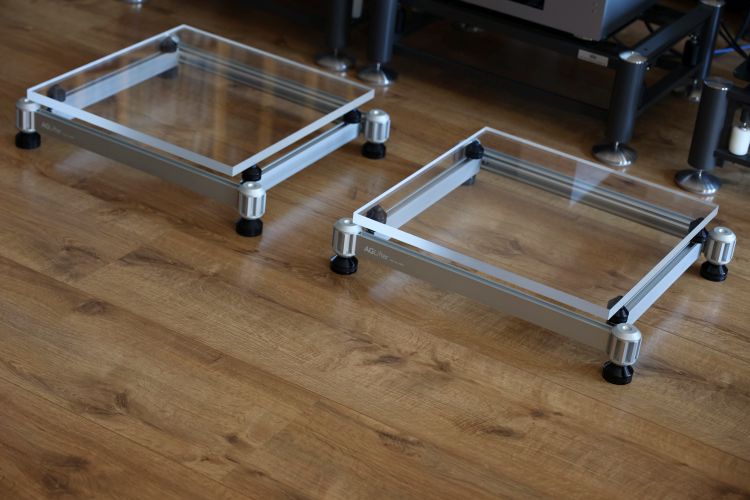
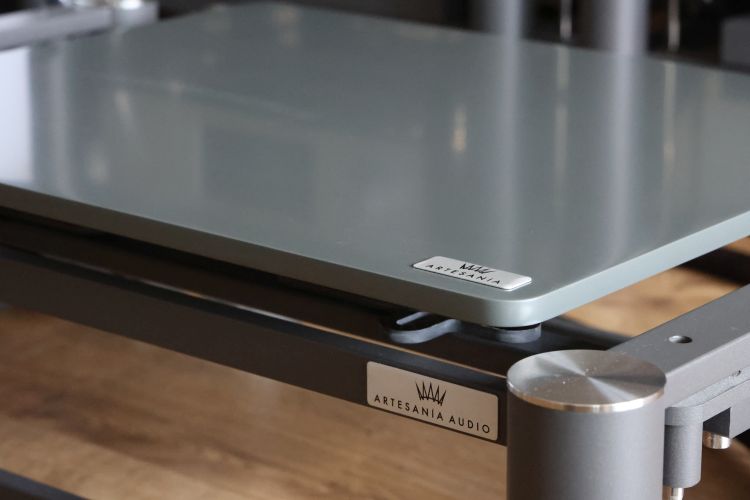
Hello,
Regarding the sound quality, I am wondering if I should replace pad black neoprene isolation discs on Artesania Exoteryc 4 shelves – for my integrated amplifer by Stillpoints Ultra SS or Ultra 6 ?
The integrated amplifer is on the lower shelf.
Do you have any recommendation ?
Thanks
Hi Pat, the Teflon/Neoprene discs can be replaced with Finite Elemente Ceraballs and, indeed, also with Stillpoints. While I have not tried this with the latter, I have tried it with Universal Ceraballs. This lead to a tighter bass and a more solid sound overall, at the expense of some fluidity and a harder, less natural midrange. Given my earlier experience with Stillpoints versus Ceraballs, I would expect the Stillpoints to have a more profound effect than Ceraballs but it is difficult for me to guesstimate which version of Stillpoints would be best. Given that the lowest level sounds most rounded and relaxed, it would be tempting to offset it with the tightest sounding feet but be aware that one can go overboard with this. Purely based on my assumptions, I think the Ultra 6 would be excessive for a single component and perhaps the ideal ones would be the SS. However, there is a potentially more appropriate alternative for the Exoteryc rack: the Carbon Fiber Arms Upgrade. These Carbon Fiber arms employ similar Teflon dampers but with Beech wood inserts. They have a very positive influence on the pacing, articulation, and tightness yet, importantly, also retain the rack’s inherent lyrical qualities.
hi Christiaan
thanks for a nice review. Found this when I was looking for information about Stillpoints. And now I am wondering if the SS would be a good choice for my speakers, as the 5 should be too much. but then again it depends …. did you try the SS on loudspeakers ?
best regards
Michael
Hi Michael, what a coincidence! It so happens that I have two sets of Ultra SS V2 for under the Magico S1 MkII’s. Just waiting for delivery of the adapter couplers. I plan to make a Compact Review of the experience.
Ohh great to hear that Christiaan… yes it is really a coincidence
Looking forward to read about the experience
Although 10 years after the review, but nevertheless:
I was advised by the distributor to place the Stillpoints Ultra Minis with the narrow side facing down towards the surface. The base of the Minis should thus point upwards so that they are touching the audio device. I have tested this and can confirm that it sounds better this way. If you look at the photos in this review, you can see that the Minis have been positioned the other way round. So perhaps they could have had an even more positive impact on the sound. The positioning of the Ultra SS in the photo is the same as recommended by the distributor.
Hi Markus, I tried them in both orientations and can confirm there is indeed a difference in the perceived sound, and the same goes for Finite Ceraballs. However, which of the two orientations is strictly “best”, may differ given the individual’s personal taste, system synergy, and the given circumstances. I always recommend experimenting and trusting ones own ears.
Ik hoor niemand over hoe je ze plaatst ik denk dat dat nog belangrijker is om alles uit de stillpoints te halen en gebruik de minis voor sterio apparatuur en de sup Iens de speakers komen veel beter tot hun recht met de grotere ss ultra mvg teun